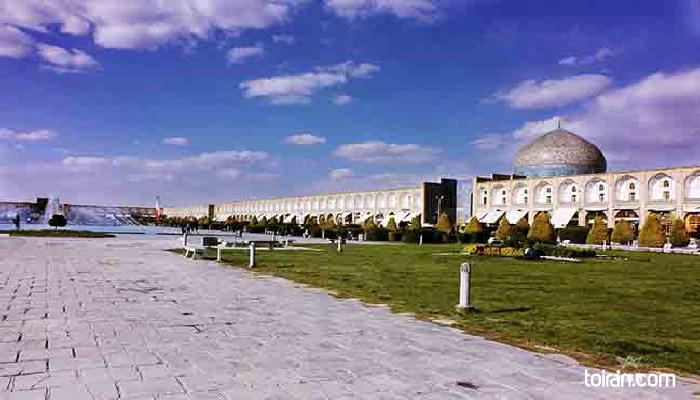The first of the four monuments dominating Naqsh-e Jahan Square, Sheikh Lutfollah Mosque was built between 1601 and 1619 for the private use of the royal family during the reign of the Safavid ruler Shah Abbas I (1571-1629).
The mosque was named after Sheikh Lutfollah, a Lebanese cleric from Jabal Amel, who was respected by Shah Abbas I and by some accounts was his father-in-law. It is said that the Safavid king designed this mosque so that Sheikh Lutfollah would have a place to lead prayers and teach classes.
Located directly across from Ali Qapu Palace, a tunnel was built under Naqsh-e Jahan Square to connect the Palace and Sheikh Lutfollah Mosque and allow the Safavid royal to avoid walking across the square to reach the mosque.
Despite its simple architecture, the finest materials were used in the construction of the mosque and the best artists were commissioned to create its complex interior and exterior decorations.
Unlike other mosques in Iran, Sheikh Lutfollah Mosque has no courtyard or minarets. There is a Thuluth inscription above the entrance of the mosque by the 17th century master calligrapher Ali Reza Abbasi.
The dome of the mosque is lavishly covered in tiles on both sides and sits on a square dome chamber. The exterior of the dome has delicate cream and turquoise colored arabesque designs that end in a turquoise star. The interior of the dome has a network of lemon-shaped compartments that decrease in size as they go towards its center. These patterns have created the illusion that a peacock’s tail, whose body is the sunrays coming in from the hole in the ceiling, has been painted inside the dome.
Inspired by mystic philosopher Suhrawardi's (1155-1191) unity of existence theory, the decorations of the interior of the dome have inspired the design of Ardabil rugs, the ‘Carpet of Wonders,’ which is the world’s biggest carpet, and the Azadi Square in Tehran.
Lighting for the mosque was provided by lattice windows surrounding the base of the dome. The base of the dome has Persian blue tilework with flower motifs and a mo’arraq tile inscription containing a few small passages from the Quran.
The Mihrab (prayer niche) of the mosque has Persian blue, turquoise and yellow moqarnas and mo’arraq tiles. Inscriptions on these tiles include poems, Quranic verses, the names of the Shia Imams and sayings by the Prophet of Islam and the Shia Imams.
Sheikh Lutfollah Mosque is a UNESCO World Heritage Site.







It truly is one of the most beautiful mosques in the world, despite its simple exterior look and the strange fact that this mosque doesn't have any minarets or courtyard, you will see the true beauty of art and architecture used in building this magnificent structure when you enter the mosque. Amazing tile works and the way they designed the entrance for the light in this mosque is one of a kind. The famous Peacock tail on the sealing that appears around sunset is one of the top features as well as the basement that has been designed the way that temperature condition always stays the same throughout the year and so many more features and details used in this private royal mosque. It's the first one on my least to visit whenever I'm in Isfahan.
مسجد شیخ لطف الله علاوه بر تمام زیبایی هایی که دارد یک خصوصیت منحصر به فرددارد. تنها مسجد بدون مناره در جهان. تنها مسجد بدون موذن در جهان. تنها مسجد مخصوص بانوان. خصوصیت سوم مسجد دلیل دو خصوصیت دیگرش هست.
هر بار که به اصفهان می روم برای دیدن این مسجد می روم. علاوه بر زیبایی بی حد و حصر با کاشی های فیروزه ای و سنگ های تراشیده شده نکان ریز زیادی دارد. مثلا جلوی در ورودی مسجد یک تکه سنگ وجود دارد که تور لیدر یک گروه گروریستی در حال توضیح دادن بود که این سنگ برای این در این مکان است که هرگاه این سنگ سایه نداشته باشد موقع نماز ظهر است. خیلی برایم جالب بود.
مسجد شیخ لطف اله یک خصوصیت جالب دیگر هم دارد. اینکه در دوره صفویه مسجدها طوری ساخته می شدند که در ورودی ره به قبله باز می شد. اما در میدان نقش جهان که یک مستطیل بزرگ است اکان آن نبود که بافت میدان حفظ شود و رو به قبله هم درب مسجد ساخته شود. به این دلیل با مهارت خاص پس از ورود به سردر مسجد که کاملا مطابق با ساختار میدان است بعد از گذر از یک راهرو مورب وارد درب دیگری می شویم که روبروی قبله هست. این نکته با عکس هوایی قابل مشاهده است که به هوش زیاد معمار آن اشاره دارد.
One of the few amazing Mosques in the world, i mean the interior design and the craftsmanship are out of this world.